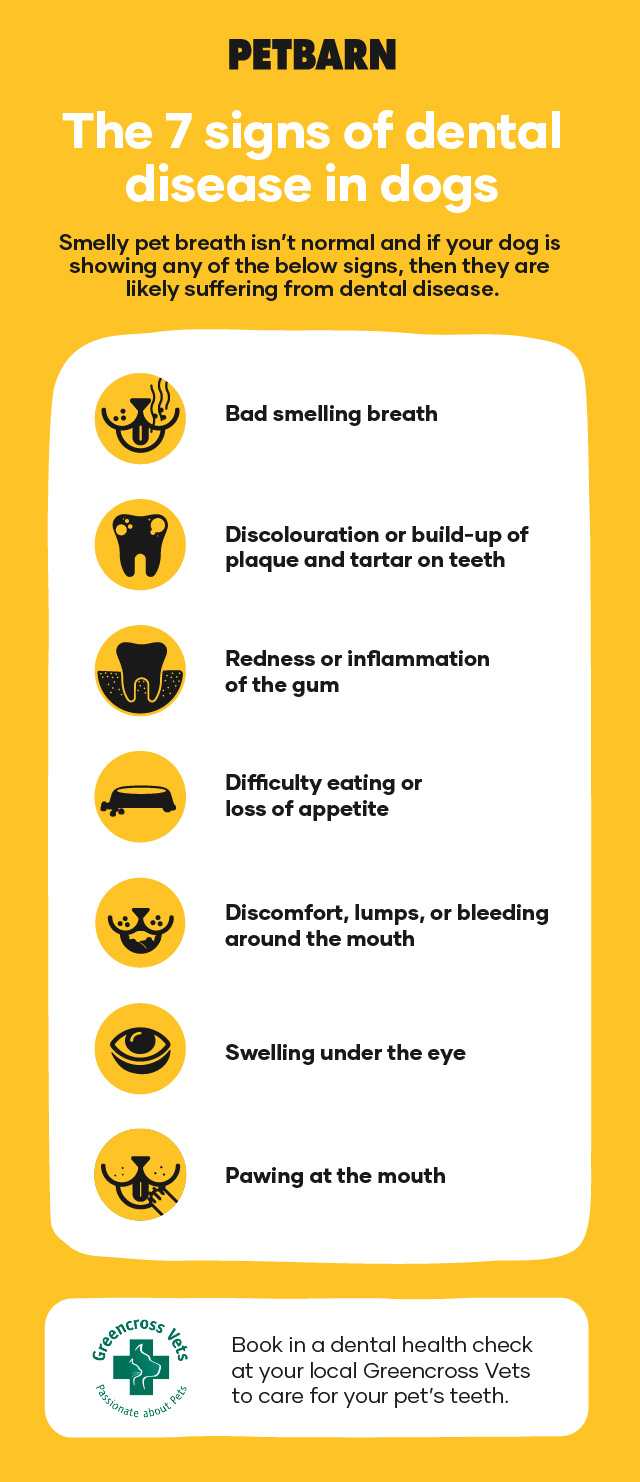Smelly dog breath isn’t normal. In fact, it’s one of the 7 signs of dental disease. Dental health plays an important role in your pet’s overall health and wellbeing, and healthy habits lead to a lifetime of wellness.
Did you know that more than 80% of dogs develop dental disease by the time they turn 3 years of age? We can help with your pet’s overall health and wellbeing for every life-stage. Learn to spot the signs so you can provide your dog with the best dental care, as advised by our Greencross Vets.
How do dogs get dental disease?
Just like humans, dental disease in dogs occurs when plaque builds up on your dog’s teeth each day and isn’t cleaned properly. Everyday activities such as eating can cause particles of food, bacteria and saliva to stick to your dog’s teeth and form a layer of plaque which is responsible for that furry feeling that we get when we don’t brush our teeth.
Over time, plaque hardens into tartar and together will grow into and under your dog’s gums, causing gingivitis (red gums) and halitosis (bad breath), inevitably leading to pain, bleeding, early tooth loss which, left untreated, can contribute to certain heart, liver and kidney problems.
This is a very painful and uncomfortable experience for your dog. Unfortunately, our pets can’t tell us that it hurts. If you can’t remember the last time you brushed your dog’s teeth, then it’s time to step-up your dog’s dental routine as there is a likelihood your pet could be suffering from dental disease. Book a dental checkup at your local Greencross Vets where they can examine and assess your dog’s teeth in order to recommend the best dental routine to keep your dog’s teeth and gums healthy.
How do I know if my dog has dental disease?
Learning how to spot the 7 signs of dental disease is the first step in providing your dog with the dental care that pets need and deserve. Look out for these signs and if in doubt, always take your dog straight to the vet so they can prescribe the appropriate treatment plan for your pet.

1. Bad breath
Does your dog have bad breath? This isn’t as normal as you might think and halitosis, or bad breath, can be an indicator that they have some form of dental disease. While undesirable, doggy habits like eating strange things can sometimes be the perpetrator of halitosis, it is often a bigger concern when an accumulation of plaque (often containing sulfur based proteins) leads to an aggregation of bacteria that causes bad breath, and can lead to dental disease.
2. Discolouration or build-up of plaque and tartar on teeth
Much like healthy human teeth, your dog’s teeth should be pearly white in colour. Teeth with yellow and brown stains are a sign that plaque and tartar have built up and must be cleaned off. Your local Greencross Vets will most likely recommend a scale and polish procedure to remove the existing disease and give you a fresh start before you begin cleaning your dog’s teeth at home and kickstarting a regular dental routine.
3. Gum redness or inflammation (gingivitis)
A major indicator that your dog’s dental disease is quite progressed is the presence of red or inflamed gums. As for humans, gingivitis is sore and causes gums to bleed. Having tender and swollen gums is very painful for your pet and if left untreated, this condition can worsen and lead to early tooth loss.
4. Difficulty eating or loss of appetite
We all know dogs love their food, so changes in their appetite are often a key indicator that something isn’t right. If your dog has stopped looking forward to mealtimes, seems to struggle to chew dry food or favours chewing on one side, this can be a sign that their dental disease is causing oral discomfort and is affecting your dog’s appetite and desire to eat. Any signs of a loss of appetite is a strong indicator you need to book a check-up with your local Greencross Vets.
5. Discomfort, lumps or bleeding around the mouth
Tooth and gum disease in dogs can cause discomfort and bleeding around the mouth and may contribute to the growth of oral tumours, such as epulis. These may be hard to spot unless they’re in the front of the mouth. You may notice your dog bleeding from the mouth or jaw. If you find a lump anywhere on your pet, take them to your local Greencross Vets for a check-up immediately as these may be malignant.
6. Swelling under the eye
Dental disease in dogs can cause symptoms that extend beyond the mouth. Infections and fractured teeth can lead to abscesses and swelling under your dog’s eyes. To treat this disease and ensure it does not return, book a dental check-up at your local Greencross Vets where they’ll recommend the best procedure for your pet.
7. Pawing at the mouth
As much as we would love our dogs to be able to verbally communicate with us, we have to make do with interpreting their body language or observing their actions. If you notice your dog pawing at their mouth, rubbing their muzzle or chattering their teeth, this could be your dog trying to tell you that they’re experiencing pain, discomfort or irritation in their mouth due to dental disease.
We know how important it is to look after our own teeth, and our pets’ teeth are no different. Regularly checking for these signs of dental disease and implementing a daily dental routine will quickly improve your dog’s dental health and prevent dental disease, as well as their overall happiness and wellbeing. The first step to giving your dog the oral care they deserve is by booking a dental health check at your local Greencross Vets today then kickstarting a regular dental routine.
Find out more about how to care for your dog’s teeth here.


